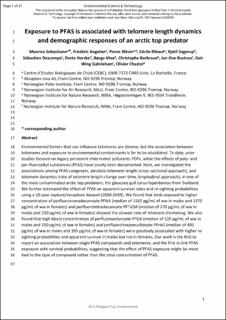| dc.contributor.author | Sebastiano, Manrico | |
| dc.contributor.author | Angelier, Frédéric | |
| dc.contributor.author | Blévin, Pierre | |
| dc.contributor.author | Ribout, Cécile | |
| dc.contributor.author | Sagerup, Kjetil | |
| dc.contributor.author | Descamps, Sebastien | |
| dc.contributor.author | Herzke, Dorte | |
| dc.contributor.author | Moe, Børge | |
| dc.contributor.author | Barbarud, Christophe | |
| dc.contributor.author | Bustnes, Jan Ove | |
| dc.contributor.author | Gabrielsen, Geir W. | |
| dc.contributor.author | Chastel, Olivier | |
| dc.date.accessioned | 2021-02-22T10:54:54Z | |
| dc.date.available | 2021-02-22T10:54:54Z | |
| dc.date.created | 2020-08-07T14:53:06Z | |
| dc.date.issued | 2020 | |
| dc.identifier.citation | Environmental Science and Technology. 2020, 54, 10217-10226. | en_US |
| dc.identifier.issn | 0013-936X | |
| dc.identifier.uri | https://hdl.handle.net/11250/2729470 | |
| dc.description.abstract | Environmental factors that can influence telomeres are diverse, but the association between telomeres and exposure to environmental contaminants is yet to be elucidated. To date, prior studies have focused on legacy persistent chlorinated pollutants (POPs), while the effects of poly- and perfluoroalkyl substances (PFAS) have been poorly documented. Here, we investigated the associations among PFAS congeners, absolute telomere length (cross-sectional approach), and telomere dynamics (rate of telomere length change over time, longitudinal approach) in one of the most contaminated arctic top predators, the glaucous gull Larus hyperboreus from Svalbard. We further estimated the effect of PFAS on apparent survival rates and re-sighting probabilities using a 10-year capture/recapture dataset (2010–2019). We found that birds exposed to higher concentrations of perfluorononadecanoate (PFNA) (median of 1565 pg/mL of ww in males and 1370 pg/mL of ww in females) and perfluorotetradecanoate (PFTeDA) (median of 370 pg/mL of ww in males and 210 pg/mL of ww in females) showed the slowest rate of telomere shortening. We also found that high blood concentrations of perfluorooctanoate (PFOA) (median of 120 pg/mL of ww in males and 150 pg/mL of ww in females) and perfluorohexanesulfonate (PFHxS) (median of 495 pg/mL of ww in males and 395 pg/mL of ww in females) were positively associated with higher re-sighting probabilities and apparent survival in males but not in females. Our work is the first to report an association between single PFAS compounds and telomeres, and the first to link PFAS exposure with survival probabilities, suggesting that the effect of PFAS exposure might be more tied to the type of compound rather than the total concentration of PFAS. | en_US |
| dc.language.iso | eng | en_US |
| dc.title | Exposure to PFAS is associated with telomere length dynamics and demographic responses of an arctic top predator | en_US |
| dc.type | Peer reviewed | en_US |
| dc.type | Journal article | en_US |
| dc.description.version | acceptedVersion | en_US |
| dc.rights.holder | Copyright © 2020 American Chemical Society | en_US |
| dc.subject.nsi | VDP::Zoologiske og botaniske fag: 480 | en_US |
| dc.subject.nsi | VDP::Zoology and botany: 480 | en_US |
| dc.source.pagenumber | 10217-10226 | en_US |
| dc.source.volume | 54 | en_US |
| dc.source.journal | Environmental Science and Technology | en_US |
| dc.identifier.doi | 10.1021/acs.est.0c03099 | |
| dc.identifier.cristin | 1822228 | |
| dc.relation.project | Framsenteret: Flagship Hazardous Substances | en_US |
| dc.relation.project | NILU - Norsk institutt for luftforskning: 114029 | en_US |
| dc.relation.project | NILU - Norsk institutt for luftforskning: 119008 | en_US |
| dc.relation.project | Norges forskningsråd: 287114 | en_US |
| cristin.ispublished | true | |
| cristin.fulltext | postprint | |
| cristin.qualitycode | 2 | |
